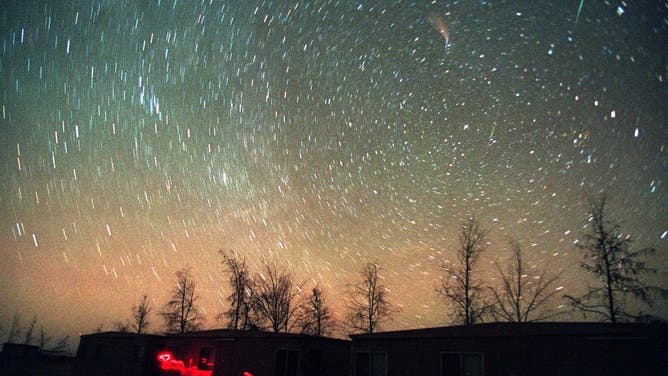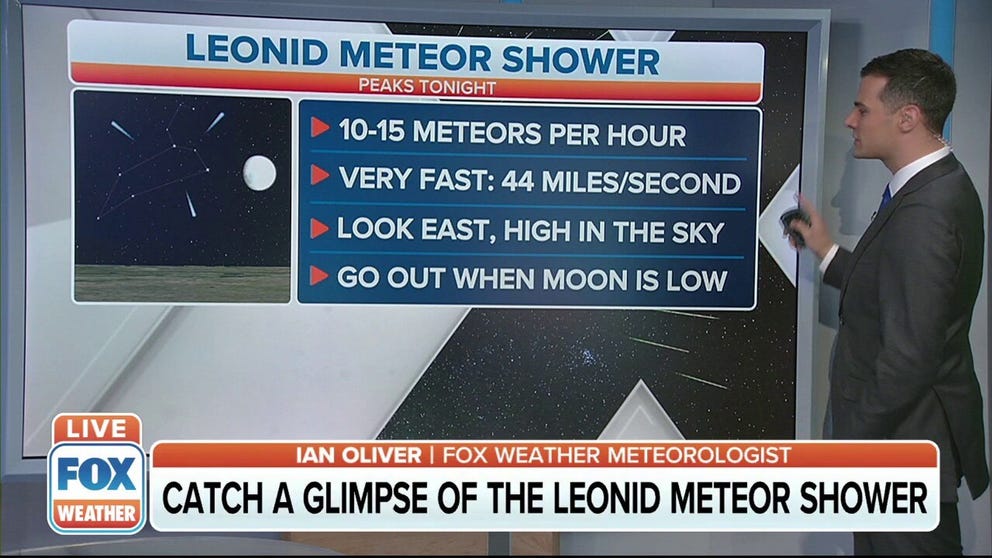The Leonid Meteor Shower peaks this week. Do you know where your closest dark sky spot is?
Deep South and Southeast will have a clear sky for Wednesday's Leonid Meteor Shower.

Cloud cover expected on November 17 around the peak of the Leonid Meteor shower.
(FOX Weather)
Usually, 15 mph would refer to a speed limit, but later this week, it relates to meteors per hour during the peak of the Leonid Meteor Shower.
The Leonids come from the 55P/Tempel-Tuttle comet and happen every November. According to NASA, the meteors are considered some of the fastest moving at 44 miles per second.
Peak Leonid meteor shower activity happens after midnight Wednesday on the east coast. For West Coast sky gazers, the show happens late night Tuesday into Wednesday.
How to view the Leonid meteor shower
The meteors will be traveling at 44 miles per second and most visible when the moon is low
The best way to view any astronomy event is to get away from city lights, finding a safe place in the dark. Allow your eyes 30 minutes to adjust to the darkness and avoid the use of electronics before looking up to the night sky.
If you aren't sure where to watch the meteor shower, the International Dark Sky Association has an interactive map with a list of dark sky locations worldwide. The organization founded the International Dark Sky Places Program in 2001 to encourage communities "to preserve and protect dark sites through responsible lighting policies and public education," according to darksky.org.
Based on the forecast for Wednesday around 3 a.m., there are several registered Dark Sky places worth taking the night to camp or visit for the meteor shower.
Stephen Collins Foster State Park in Georgia and Big Bend National Park in Texas will have the least cloud cover and provide optimal viewing to spot a shooting star.
The Deep South and most of the South East will have the best viewing conditions Wednesday before dawn.
Unfortunately, cloud cover will make viewing the meteors difficult Tuesday night into Wednesday morning for the Chicago area and most of Los Angeles.
Meteor shower vs. meteor storm

A photo from November 18, 1999, shows a Leonid meteor storm over the Azrak desert, 90km east of Amman. The storm packed up to some 1,500 meteors per hour visible with the eye. (Photo by JAMAL NASRALLAH / AFP via Getty Images)
(Getty Images)
According to NASA, every 33 years the Leonids produce a meteor storm raining down thousands of meteors around Earth.
A meteor shower is usually dozens of meteors an hour, whereas a storm is at least 1,000 per hour.
It takes comet Tempel-Tuttle 33 years to orbit the sun once, and when it does, pieces of space debris interact with Earth's atmosphere to create the Leonids originating from the comet.
The last Leonid Meteor Storm happened in 2002, according to NASA. However, the 1999 Leonid Meteor Shower was highly active with 1,500 meteors per hour.

An illustration of the Leonid Meteor Shower of 1833. (Photo by: Universal History Archive/Universal Images Group via Getty Images)
(Getty Images)
Some of the most notable Leonid Meteor Storms happened in the 1800s. Illustrations from a storm in 1833 show there were so many meteors it looked like the sky was raining stars.
A similar event happened in 1966, according to NASA, when "thousands of meteors per minute fell through Earth's atmosphere during a 15-minute period."
